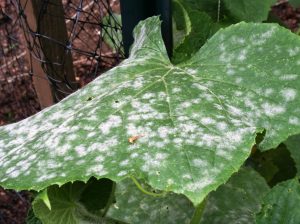Contact: Ken Davis
Watters Garden Center
Cell: 603-456-3581(Please Do Not Publish)
NEWS RELEASE
IMMEDIATE RELEASE: Garden Alert! Powdery Mildew spreads because of Monsoon rains.

Sept 20, 2022– Prescott, Arizona, a white powder is spreading dangerously through vegetable and flower beds, killing plants. This disease is circulating quickly, taking over entire gardens.
Powdery Mildew is one of our most prevalent and recognized plant diseases in the rainy season. Virtually no plant is immune, but some are more susceptible than others. Lilacs, crabapples, phlox, monardas, roses, grapes, squashes, and cucumbers are likely targets for this powdery pest.
Recognizing Powdery Mildew – Take a close look at the photo of a squash leaf in my garden. Powdery Mildew looks like powdered white splotches covering the foliage and stems. There are several types of powdery mildew fungi, but they all look the same.
Photosynthesis is impaired if enough of the leaf surface becomes covered. It stresses plants, and severe infections weaken a plant’s health. Infected leaves often drop prematurely. This can be a particular problem for edible crops since insufficient photosynthesis can diminish the flavor of the fruit or vegetable. If buds become infected, they may not open or mature at all.
Mildew is Host Specific – Powdery Mildew fungi are Host-specific, meaning the different powdery mildew fungi infect other plants. The Powdery Mildew on your lilacs will not spread to your grapes or roses.
Cause and Effect – Powdery Mildew seem to be everywhere. All Powdery Mildew thrives in the same conditions. They overwinter in plant debris and produce spores in spring carried by the wind, birds, insects, and splashing water. The growth and spread of powdery Mildew are encouraged by dampness, high humidity, poor air circulation, and crowded plants in the garden. All these conditions appear in the mountains of Arizona at the start of our monsoon season.
Controls – First and foremost, choose healthy plants from your garden center. Healthy plants are less likely to become diseased and can better fend for themselves once an attack happens.
Infected Plants – Just a little work fends off pesky Powdery Mildew. Remove and destroy all infected plant parts, especially yellow leaves and those covered mainly by white spores. Try to water infected plants at ground level to keep leaves as dry as possible. Spray the entire plant from top to bottom with ‘Copper Fungicide.’ Because powdery Mildew favors young, succulent growth, don’t fertilize until the problem is corrected.
Spray weekly until new leaves emerge clean and disease free. At this stage, feed your plants, and they will take off with new growth. If you aren’t sure, consult one of the plant experts here at Watters Garden Center.
Please – Powdery Mildew spreads quickly to other plants. If you are bringing a leaf sample with you, place it in a ziplock bag or a jar to contain the spores and prevent spreading here at the garden center. Thank you.
Samples of Powdery Mildew from local gardens on Pinterest. Follow our board for local updates.
Ken Lain can be found throughout the week at Watters Garden Center, 1815 W. Iron Springs Rd in Prescott, or contacted through his website at WattersGardenCenter.com or Top10Plants.com.

